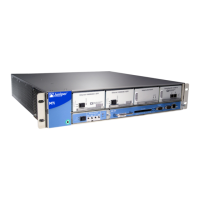The built-in tunnel interface on the CFEB or CFEB-E is configured the same way as a
PIC. For information about configuring the built-in tunnel interface, see the Junos OS
Services Interfaces Library for Routing Devices.
•
Optional Adaptive Services Module (ASM)—Provides one or more services on one PIC.
See “M7i Adaptive Services Module” on page 67 for more information.
The CFEB and CFEB-E are hot-pluggable when you replace a CFEB with a CFEB or a
CFEB-E with a CFEB-E. Upgrading or downgrading a CFEB device requires a system
reboot, as described in “Upgrading and Downgrading the CFEB and CFEB-E” on page 185.
You can remove and replace the CFEB or CFEB-E without powering down the router, but
the routing functions of the system are interrupted when it is removed.
CFEB
The CFEB has the following major components:
•
Processing components:
•
266-MHz CPU and supporting circuitry
•
Integrated ASIC
•
33-MHz PCI bus
•
Storage components:
•
128-MB SDRAM for packet memory
•
128-MB SDRAM for the microkernel
•
8-MB SSRAM for route lookup
•
4-MB SSRAM for control memory
•
Services interfaces:
•
Built-in tunnel interface
•
Optional Adaptive Services Module
•
System interfaces:
•
100-Mbps link for internal interface to the Routing Engine
•
19.44-MHz reference clock—Generates clock signal for SONET/SDH PICs.
•
I2C controller to read the I2C/EEPROMs in the PICs and temperature sensors
•
I2C/EEPROM containing the serial number and revision level
•
Two 512-KB boot flash EPROMs (programmable on the board)
•
One PowerPC 8245 integrated processor
•
Three LEDs—A green LED labeled OK, a red LED labeled FAIL, and a blue LED labeled
MASTER indicate CFEB status.
Copyright © 2019, Juniper Networks, Inc.64
M7i Multiservice Edge Router Hardware Guide

